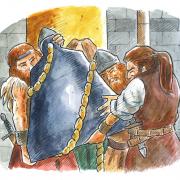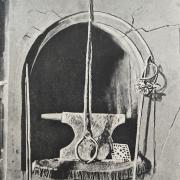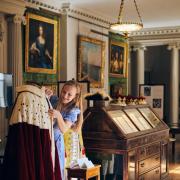History and folklore writer Chris Horlock retells five of the county's spookiest stories
Brighton's sunken ship
One of the oldest Sussex ghost stories reads like a mixture of Arthurian legend and an episode of Game of Thrones. It starts during a battle between two feuding 'noble' families, namely the de Warennes of Lewes and the Mortains of Pevensey.
The date isn't exactly clear and never has been, but presumably is late in the 11th century. There were often skirmishes between neighbours, who took any chance to extend the borders of their lands or even just fancied a bit of a fight with someone. During this battle, which took place at Lewes, the wife of de Warenne was watching from the keep of the castle with her baby – Manfred – in her arms.
When she saw Lord Pevensey make for her husband with his battle-axe, she lifted her son above her head and called on St Nicholas, protector of the faithful, to spare her husband. If he did, her son, when grown, would travel to Byzantium and offer up a treasure owned by the de Warrens to the tomb of the Virgin Mary (namely a belt worn by St Nicholas himself) when mortal.
How she saw her husband about to be axed a great distance away and how she explained everything to St Nicholas in the few seconds before the fatal blow are both unclear. But, as the story goes, Earl de Warenne was indeed spared. He managed to fatally wound Lord Pevensey and subsequently win the battle.
Every year after that, the great victory was celebrated at Lewes Castle with much feasting and revelry, but at the 20th-anniversary celebration, an icy wind blew through the hall extinguishing the candles, then lightning flashes lit up the wall tapestries, where the battle was seen to come to life again. But as Lord Pevensey raised his axe to strike, the scene faded, the wind died, and the hall was 'as black as midnight'. This was seen as a great omen. De Warenne immediately travelled to Brighthemlston (Brighton) to seek guidance from the priests at St Bartholomew's Chapel. They said that he must at once send Manfred to Byzantium with the belt to fulfil the old promise.
He sailed from what is now Newhaven on a quest that lasted a whole year and gave up the prized relic as pledged.
On May 17th (and again, the year is never specified), he returned, his ship first spotted off Wordinges (Worthing). The de Warenne family gathered on the hill outside St Nicholas Church in Brighthelmston, singing hymns of thanksgiving as the ship neared land. But at Shoreham, the vessel struck some submerged rocks and keeled over, instantly sinking, with everyone on board drowning, including Manfred.
Lady de Warenne died of shock on the spot and was later buried exactly where she'd fallen, just outside the main door of the church. Earl de Warenne built a new church at Brighthelmston, some of which survives today (the zealous Victorians' improved' it in the 1850s). According to legend, on May 17 every year, the ghostly ship can still be viewed from the hill, silently sinking as it had done centuries earlier.

For whom the bell tolls in Telscombe
Coming much more up to date, a chilling incident occurred at the tiny village of Telscombe, a very isolated rural community near the coast above Telscombe Cliffs, which can only be approached by one road. It took place in 1991, involving a man named Darrell Cook, whose car inexplicably broke down outside the church, following an evening's drive around Sussex with a friend.
The car's problem was clearly electrical – Mr Cook was a garage mechanic – but while working the ignition key backwards and forwards, a startling thing happened. The bell in the church of St Lawrence began slowly tolling. There were no lights on in the church, no one else was about, and it was 1.30 in the morning.
Mr Cook fiddled around for about five minutes, trying to restore power to his vehicle, and during the whole time, the bell kept ringing out. His travelling companion distinctly heard it too. Finally, a twist of the key brought the engine to life, and at that exact moment, the bell fell silent.
The place where the car stalled is notorious for ghostly activity; the spectre of a man and his dog are frequently seen there. In the 2001 book Brighton Ghosts, Hove Hauntings, by the late John Rackham, from which this story is taken, many other unsettling stories are told of Telscombe, showing that for a place with a population of less than 50, it's a remarkably haunted community.
READ MORE: Captivating 1880s photo shows class of Glynde School in East Sussex

Walking on air in Upper Dicker
Michelham Priory, a former Augustine Priory, is said to be so haunted it's said you have to be really unlucky not to have a strange encounter during a visit. Parts of the building date to the 13th century, yet it's still surrounded by the longest medieval moat in England.
Of the scores of stories and sightings over the years. the most perplexing has to be one of 1927, when a young overseas couple visiting the priory were in one of the interior rooms, referred to as 'the hall', reading an explanatory notice on one of the walls. A man in Tudor style dress suddenly appeared near the ceiling above them, in a corner, then walked in a diagonal direction down to the floor, as if coming down a staircase, although a staircase clearly wasn't there. Nearing the floor by the fireplace, he took a little jump and passed through a doorway. As if that wasn't enough, a Tudor looking woman, suddenly materialised from nowhere, rushed past the couple as if pursuing the man, heading in his direction. All very startling, to say the least, particularly in broad daylight.
Sadly, it isn't known if a staircase once existed where the man descended. It's possible that he was actually on an external staircase when the hall didn't exist and was a later extension. What gives this particular story some credence is the trajectory of the man, also how he took the small jump.
If the couple were fabricating a story, they would almost certainly say a Tudor looking man appeared next to them or came through a door, not appearing in mid-air, from a corner of the ceiling and descending via an unseen staircase. The small jump the spectre did is a detail that, again a fabricated tale, probably wouldn't include.

Rye's ghostly duel
A similarly hard to believe encounter occurred at the Mermaid Inn, Rye, one of Sussex's most ancient hostelries, which has more than a few regular ghosts. A guest in room 16, the Elizabethan Room, was woken from sleep by a rumpus occurring around her bed.
She claims she saw two men dressed in doublet and hose fighting each other with swords around the room. One was run through, slumped to the floor, and the other dragged the lifeless body to a trapdoor in the corner, pulled it open and dropped the body down a shaft, which still exists. Another undated story, but once again, a story with a uniqueness almost too fanciful to fabricate.
READ MORE: Everything you need to know about Sussex Day on 16 June

Belligerent bag of soot
If the previous story seems more than a touch far-fetched, how about ending with a haunting involving a bag of soot? This took place in Crowborough, in the late 19th century, in the Jarvis Brook area. On several nights, a spectral bag of soot appeared and 'chased' after people walking in Walshes Road.
A flippant blacksmith, after ridiculing the idea at the local pub, apparently was vigorously chased when he left, running full speed down the hill in order to get away, while a companion looked on. When the blacksmith arrived home, he slammed and bolted the door, the bag remaining outside on the front step, before 'hopping off'. Was the bag the spirit of a chimney sweep with a grudge against people of the area, who maybe had turned his services away to clean their chimneys themselves?




























